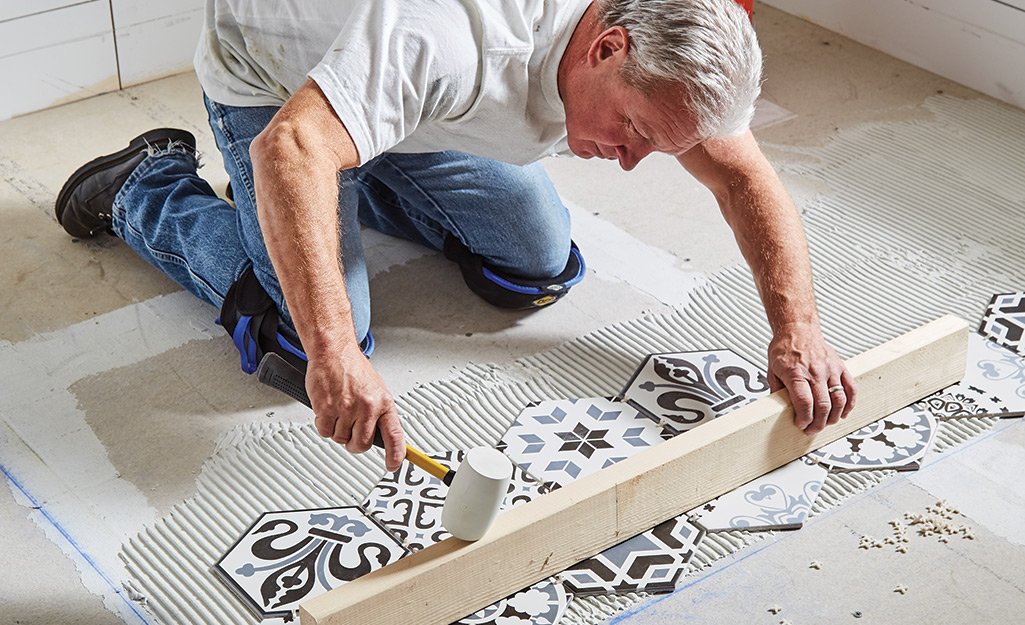Kitchen Floor Tiles: Everything You Need To Know
Monochrome tiles by one of our suppliers, Mandarin Stone
If you’re looking to update your kitchen floor, one option you might consider is updating your floor tiles, which is a wide ranging category in itself. While the list of options might seem daunting, understanding the ins and outs of different tiles can help make the process easy. Installation considerations, and a knowledge of maintenance requirements can streamline your decision-making process, and give you an inkling of what you might want and what your home might need.
In this guide, we delve into everything you need to know about kitchen floor tiles, ensuring you make an informed choice that suits your style, budget, and lifestyle.
Why choose kitchen floor tiles?
Mixed pattern kitchen floor tiles by another of our suppliers, Domus.
Kitchen floor tiles have a range of benefits that make them a popular choice among homeowners. Not only can they give your kitchen a more homely feel, they also provide durability, easy maintenance, and resistance to moisture and stains. Ceramic and porcelain kitchen tiles are also heat resistant, so can’t be damaged from hot appliances or spilt liquids. Whether you prefer the timeless elegance of natural stone or the sleek versatility of porcelain tiles, there's a tile option to suit every taste and requirement.
It’s also worth considering the environmental benefits of tiles. At Beams we use tiles made from a high percentage of recycled materials and many tiles are made from clay, sand and minerals which have a lower environmental impact than other materials.
Types of kitchen floor tiles
Milan Tumbled Limestone, by Mandarin Stone
From classic ceramic, to trendy wood-look porcelain, every type of kitchen floor tile offers unique features and advantages. Here are some popular options to consider:
Ceramic tiles:
known for their durability and affordability, ceramic tiles come in a variety of colours, patterns, and finishes, making them a versatile choice for any kitchen. Ceramic tiles are crafted from a mix of clays and minerals, fired at high temperatures to create a durable, versatile flooring option.
Good for: Affordability
Porcelain tiles:
Renowned for their strength and water resistance, porcelain tiles are an ideal option for high-traffic areas like the kitchen. They come in an array of designs, including wood, stone, and concrete looks, providing endless possibilities for customisation. Porcelain tiles are made from a refined clay mixture and fired at higher temperatures than ceramic tiles, resulting in a denser, more durable product. They are often used in kitchens for their robustness and low water absorption rates.
Good for: Durability
Natural stone tiles:
For a luxurious and timeless look, natural stone tiles such as limestone, marble, granite, and travertine are unparalleled. While they require more maintenance than ceramic or porcelain tiles, as they stain easily, but their beauty and durability make them a worthwhile investment. Each tile is distinct, adding a luxurious, natural element to kitchen flooring.
Good for: Luxury
Vinyl tiles:
Budget-friendly and easy to install, vinyl tiles are a popular choice for kitchen floors. Available in a wide range of colours and patterns, they mimic the look of natural materials without the maintenance requirements. Vinyl tiles are made from synthetic materials, providing a cost-effective and versatile flooring solution. They have gained popularity due to their ease of installation and maintenance.
Good for: Low-maintenance
Installation and maintenance tips
Patterned porcelain tiles. Credit: The Home Depot
Proper installation and maintenance are essential for ensuring your kitchen floor tiles last and remain in tip-top condition. Here’s a checklist of considerations:
Ideally hire a professional installer to ensure proper tile placement and grout sealing, especially for natural stone tiles.
Regularly sweep or vacuum your tile floors to remove dirt and debris, preventing scratches and stains.
Clean spills promptly using a mild detergent and water to prevent staining and discoloration.
Consider applying a sealant to porous tiles like natural stone to protect them from moisture and stains.
Avoid using harsh chemicals or abrasive cleaners, as they can damage the surface of your tiles.
Conclusion
Slab tiles by Domus
Choosing the perfect kitchen floor tiles requires careful consideration of factors such as material, design, installation, and maintenance. It’s worth thinking about what your own lifestyle requires, does a busy family life require durability over beauty, or do you need a budget friendly choice for now? By understanding the advantages and limitations of different tile types and adhering to proper care practices, you can create a beautiful and functional kitchen space that enhances your home's value and appeal. Whether you opt for classic ceramic tiles or luxurious natural stone, investing in high-quality kitchen floor tiles is a decision you won't regret.
At Beams we use high-quality materials to create kitchens that last, all at a mid-range price point. This way you get the most value for your money and the most comfort from your home.
If you’d like us to guide you from design to the completion of the work by our vetted contractors, then get your free estimate today:





